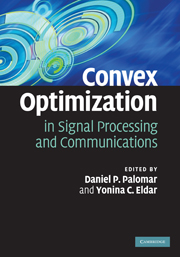Book contents
- Frontmatter
- Contents
- List of contributors
- Preface
- 1 Automatic code generation for real-time convex optimization
- 2 Gradient-based algorithms with applications to signal-recovery problems
- 3 Graphical models of autoregressive processes
- 4 SDP relaxation of homogeneous quadratic optimization: approximation bounds and applications
- 5 Probabilistic analysis of semidefinite relaxation detectors for multiple-input, multiple-output systems
- 6 Semidefinite programming, matrix decomposition, and radar code design
- 7 Convex analysis for non-negative blind source separation with application in imaging
- 8 Optimization techniques in modern sampling theory
- 9 Robust broadband adaptive beamforming using convex optimization
- 10 Cooperative distributed multi-agent optimization
- 11 Competitive optimization of cognitive radio MIMO systems via game theory
- 12 Nash equilibria: the variational approach
- Afterword
- Index
7 - Convex analysis for non-negative blind source separation with application in imaging
Published online by Cambridge University Press: 23 February 2011
- Frontmatter
- Contents
- List of contributors
- Preface
- 1 Automatic code generation for real-time convex optimization
- 2 Gradient-based algorithms with applications to signal-recovery problems
- 3 Graphical models of autoregressive processes
- 4 SDP relaxation of homogeneous quadratic optimization: approximation bounds and applications
- 5 Probabilistic analysis of semidefinite relaxation detectors for multiple-input, multiple-output systems
- 6 Semidefinite programming, matrix decomposition, and radar code design
- 7 Convex analysis for non-negative blind source separation with application in imaging
- 8 Optimization techniques in modern sampling theory
- 9 Robust broadband adaptive beamforming using convex optimization
- 10 Cooperative distributed multi-agent optimization
- 11 Competitive optimization of cognitive radio MIMO systems via game theory
- 12 Nash equilibria: the variational approach
- Afterword
- Index
Summary
In recent years, there has been a growing interest in blind separation of non-negative sources, known as simply non-negative blind source separation (nBSS). Potential applications of nBSS include biomedical imaging, multi/hyper-spectral imaging, and analytical chemistry. In this chapter, we describe a rather new endeavor of nBSS, where convex geometry is utilized to analyze the nBSS problem. Called convex analysis of mixtures of non-negative sources (CAMNS), the framework described here makes use of a very special assumption called local dominance, which is a reasonable assumption for source signals exhibiting sparsity or high contrast. Under the locally dominant and some usual nBSS assumptions, we show that the source signals can be perfectly identified by finding the extreme points of an observation-constructed polyhedral set. Two methods for practically locating the extreme points are also derived. One is analysis-based with some appealing theoretical guarantees, while the other is heuristic in comparison, but is intuitively expected to provide better robustness against model mismatches. Both are based on linear programming and thus can be effectively implemented. Simulation results on several data sets are presented to demonstrate the efficacy of the CAMNS-based methods over several other reported nBSS methods.
Introduction
Blind source separation (BSS) is a signal-processing technique, the purpose of which is to separate source signals from observations, without information of how the source signals are mixed in the observations. BSS presents a technically very challenging topic to the signal processing community, but it has stimulated significant interest for many years due to its relevance to a wide variety of applications.
- Type
- Chapter
- Information
- Convex Optimization in Signal Processing and Communications , pp. 229 - 265Publisher: Cambridge University PressPrint publication year: 2009
- 1
- Cited by

